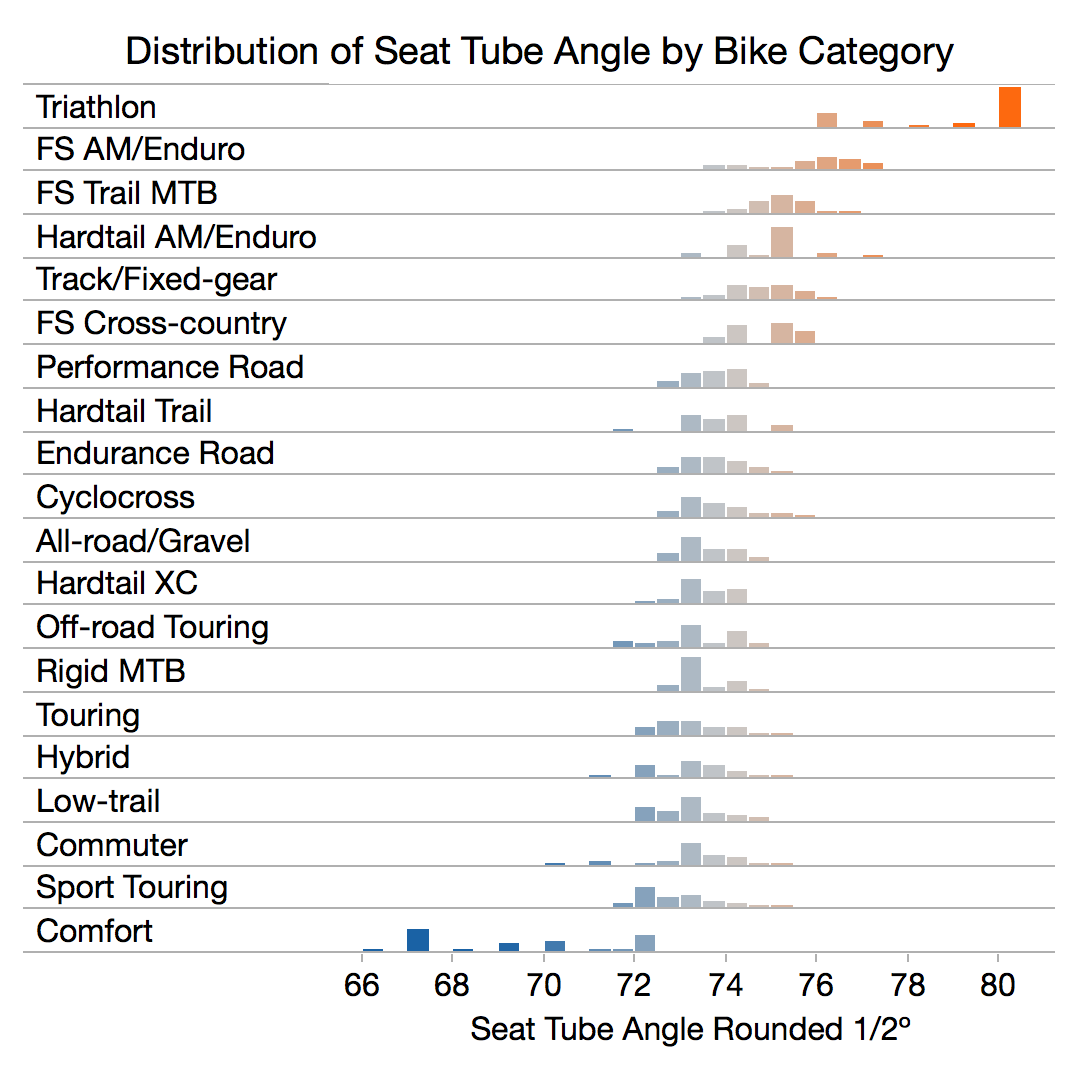Seat Tube Angle
What is Seat Tube Angle?
Seat tube angle is the angle of the seat tube relative to the horizontal plane, measured from behind the seat tube (e.g. a perfectly-upright seat tube would be 90º and would decrease in angle as the tube tilts backward).
Why does it matter?
Seat tube angle affects saddle placement which in turn determines the rider’s default position on the bike. This position is a major factor of bike fit and handling.

Slack angles are more common in bikes designed for a more upright rider position such as Touring, Commuter, and Comfort bikes. This accommodates the tendency for riders in an upright position to pivot their body rearwards.
Steeper angles are more common in bikes designed for a more aggressive, performance-oriented rider position such as Triathlon, Track, and mountain bikes. In particular, progressive mountain bike designs with slack Head Tube Angles are increasingly adopting steeper seat tubes in order to preserve ideal rider weight distribution between the front and rear tires, thus improving handling when climbing.
Inconsistent Seat Tube Angles
As a bike design is scaled down to fit smaller riders, Toe Overlap (the tendency for the rider's toes to catch on the trailing edge of the front wheel when wide turns are taken) can become a problem. One approach bike designers take to mitigate this is to scale down a bike by shortening the Top Tube Length without shortening the Front Center proportionally (or at all in some cases). This can mitigate Toe Overlap with the downside of placing the rider too far forward on the bike relative to the bottom bracket (or require that the rider adopt a more setback seatpost which negates the move towards a smaller size).
In the example above, the orange bike appears smaller since the seat tube and top tube have been shortened. Indeed, the effective top tube measurement is shorter on the orange bike and the default saddle position will be closer to the handlebars. In reality, however, the fore-aft positioning of the saddle should be determined relative to the bottom bracket and it’s likely that the orange bike would require a seatpost with significant rearward offset in order to fit properly. At this point the effect of the shortened Effective Top Tube would be negated and both bikes would fit and handle exactly the same. Unfortunately, these scenarios are hard to identify when doing a test ride of a bike and they can easily result in a smaller rider ending up with a poorly-fitting bike.
One quick way to check for this design compromise is to see if there is a sharp jump in seat tube angle on the smaller sizes of a bike model. If so, beware that the fit may likewise be compromised. This does not always mean that the design is “bad” but caution should be exercised to make sure that a proper fit can be achieved. Stack and Reach are the preferred measure of a bike’s true size in this case.
Curved and variable angle seat tubes
Bike Insights provides several options to choose from when adding new bike geometry to the database. In addition to the standard Seat Tube Angle, some bikes have a curved seat tube that is offset from the bottom bracket.
In these situations, it’s important to try to identify the type of Seat Tube Angle measurement(s) being used in a bike’s geometry table. It’s common for bike brands to specify an “Effective” Seat Tube Angle which describes the angle from the center of the bottom bracket up to virtual saddle position or other reference point. Unfortunately, the exact method of determining this reference point is often not specified in a bike’s geometry table. When possible, reference the brand’s bike geometry diagram and choose the best option from the choices provided.
A less common scenario is for bikes having an aero-style seatpost with a range of fore-aft positions. In this case, please average the minimum and maximum angles before adding to the Bike Insights database.
